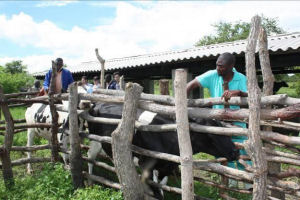
Economic Growth Fact Sheet
 |
| USAID/Zambia supports improved access to veterinary services (Photo: C. Mahoney USAID/Zambia) |
Zambia has tremendous agriculture and natural resource potential. Historically, however, the country has not managed those resources for the benefit of the majority of Zambians. Over 80% of the rural population, the majority of Zambians live in poverty. Well-managed agricultural growth, the key to reducing rural poverty, must consist in: 1) improved policy direction from the Zambian government; 2) increased diversification of agricultural production; 3) increased access for diverse commodities to domestic and regional markets; and 4) maintaining the natural resource base.
The United States, through USAID, implements two initiatives aimed at reducing rural poverty in targeted areas, and improving the management of the natural resource base in Zambia. USAID/Zambia coordinates the U. S. government’s Feed the Future Initiative, which works with the Zambian government to address policy issues, develop structures to stabilize and open markets, assist small and medium scale farmers to diversify production, improve productivity and deepen market penetration. USAID/Zambia also implements the Global Climate Change program, which aims to support the Zambian government and rural communities in efforts to reduce emissions through more sustainable forest management. These Initiatives work in conjunction with programs in health, governance, and education.
AREAS OF INVOLVEMENT
Increased Agricultural Productivity
USAID/Zambia programs work successfully with small-scale farmers to increase the efficiency and productivity of their operations. Initiated in 2011, the Zambian Agricultural Research and Development Program is promoting improved technologies such as maize and legume rotations, improved groundnut varieties, Vitamin A-rich maize and orange-fleshed sweet potatoes. On-going and new value chain programs increase access to necessary inputs, information, and technology, and dramatically increase the productivity and competitiveness of male and female small-scale farmers.
In 2011, through USAID/Zambia support, over 200,000 small-scale Zambian farmers benefitted from improved inputs, such as fertilizers and veterinary services, provided through sustainable, private-sector input agents. The Feed the Future program will target up to fifty percent of the small-scale farming households in Zambia’s Eastern Province with technologies to increase agricultural productivity. USAID/Zambia promotes improved technologies through partnerships with the Conservation Farming Unit within the Zambia National Farmers’ Union, national and international agricultural research institutes, non-governmental organizations, and the private sector.
Increased Trade and Reduced Barriers to Market Access
USAID assisted in the development of the Zambia Agricultural Commodity Exchange (ZAMACE), Zambia’s first commercial commodity exchange. ZAMACE provides open and stable trading and is now expanding markets to small farmers. The World Food Program has adapted its local procurement policy to use ZAMACE, the first time the agency has purchased across a commodity exchange in Africa.
USAID has also worked to increase the access of Zambian non-traditional export products to domestic, regional, and international markets. In 2009, USAID supported 81 Zambian companies to improve their capacities to enter the export market. Over 50 of these companies completed exports to Southern Africa, Europe, and North America with a total value of $57,000,000.
Expanded Markets and Trade
USAID/Zambia programs support the creation of an enabling environment for agricultural development based on a robust private sector. The Government of Zambia made a commitment to the objectives of the Comprehensive African Agriculture Development Program (CAADP), to increase productive investment to the agricultural sector, and increase the growth rate of agriculture. USAID/Zambia supports activities that build Zambian capacity to conduct research and adopt policies that enable the best use of public resources to reduce poverty and encourage private sector growth. The promotion of local processing and improved market infrastructure will increase trade in groundnuts, soya, and horticulture. USAID/Zambia will leverage financing and promote market linkages to increase the access of Zambian agricultural products to domestic, regional, and international markets.
Improved Resilience of Vulnerable Households
Feed the Future investments will target vulnerable households with an integrated approach to building assets and reducing risk through linking these households to value chain interventions and community, district and provincial health systems. Special attention is given to enabling very poor women to participate in expanding opportunities as producers, service providers and entrepreneurs.
Improved Natural Resource Management
USAID/Zambia programs support the Government of Zambia in the development of a national Reducing Emissions from Deforestation and Degradation (REDD+) strategy outlining how Zambia will reduce emissions through reduced deforestation and forest degradation. USAID/Zambia supports policy dialogue and sustainable management of forests at the local level, and will pilot new systems for monitoring forest carbon emissions, enabling Zambian stakeholders to eventually receive payments for their forest conservation efforts.
Download a PDF version of the Economic Growth Fact Sheet [118KB]


